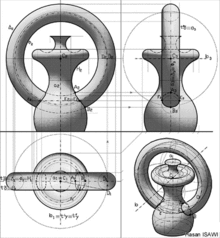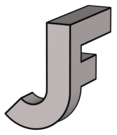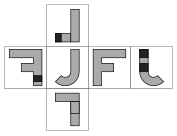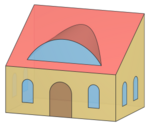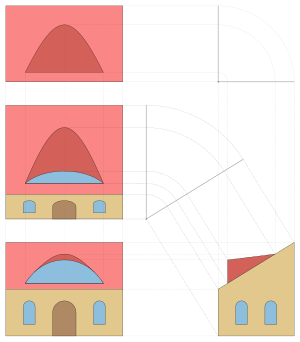616:
go directly to the solution view), this shorter protocol is accounted for in the layout. Where the one step protocol replaces the two-step protocol, "double folding" lines are used. In other words, when one crosses the double lines he is not making a circuitous 90° turn but a non-orthodirectional turn directly to the solution view. As most engineering computer graphics packages automatically generates the six principal views of the glass box model, as well as an isometric view, these views are sometimes added out of heuristic curiosity.
499:
289:
278:
249:
121:
258:
25:
66:
236:
380:(1746–1818), who is usually credited with the invention of descriptive geometry. Gaspard Monge is usually considered the "father of descriptive geometry" due to his developments in geometric problem solving. His first discoveries were in 1765 while he was working as a draftsman for military fortifications, although his findings were published later on.
609:
of either of the two elements of intersections (one element, if cones are tangent) between the two cones produces the desired solution view. If the cones do not intersect a solution does not exist. The examples below are annotated to show the descriptive geometric principles used in the solutions. TL = True-Length; EV = Edge View.
643:
615:
The potential standard employs two adjacent, standard, orthographic views (here, Front and Top) with a standard "folding line" between. As there is no subsequent need to 'circuitously step' 90° around the object, in standard, two-step sequences in order to arrive at a solution view (it is possible to
584:
General solutions are a class of solutions within descriptive geometry that contain all possible solutions to a problem. The general solution is represented by a single, three-dimensional object, usually a cone, the directions of the elements of which are the desired direction of viewing (projection)
608:
In the examples, the general solution for each desired characteristic solution is a cone, each element of which produces one of an infinite number of solution views. When two or more characteristics of, say those listed above, are desired (and for which a solution exists) projecting in the direction
427:
view; projecting in a direction parallel to a true length line view yields its point view, projecting the point view of any line on a plane yields the plane's edge view; projecting in a direction perpendicular to the edge view of a plane will yield the true shape (to scale) view. These various views
480:
Three-dimensional, computer modeling produces virtual space "behind the tube", as it were, and may produce any view of a model from any direction within this virtual space. It does so without the need for adjacent orthographic views and therefore may seem to render the circuitous, stepping protocol
397:
Project two images of an object into mutually perpendicular, arbitrary directions. Each image view accommodates three dimensions of space, two dimensions displayed as full-scale, mutually-perpendicular axes and one as an invisible (point view) axis receding into the image space (depth). Each of the
422:
of a line (i.e., full size, not foreshortened), the point view (end view) of a line, the true shape of a plane (i.e., full size to scale, or not foreshortened), and the edge view of a plane (i.e., view of a plane with the line of sight perpendicular to the line of sight associated with the line of
409:
Each new view may be created by projecting into any of an infinite number of directions, perpendicular to the previous direction of projection. (Envision the many directions of the spokes of a wagon wheel each perpendicular to the direction of the axle.) The result is one of stepping circuitously
383:
Monge's protocols allow an imaginary object to be drawn in such a way that it may be modeled in three dimensions. All geometric aspects of the imaginary object are accounted for in true size/to-scale and shape, and can be imaged as seen from any position in space. All images are represented on a
621:
405:
Each new projection utilizes a dimension in full scale that appears as point-view dimension in the previous view. To achieve the full-scale view of this dimension and accommodate it within the new view requires one to ignore the previous view and proceed to the second previous view where this
476:
A standard for presenting computer-modeling views analogous to orthographic, sequential projections has not yet been adopted. One candidate for such is presented in the illustrations below. The images in the illustrations were created using three-dimensional, engineering computer graphics.
632:
401:
Either of these images may serve as the beginning point for a third projected view. The third view may begin a fourth projection, and on ad infinitum. These sequential projections each represent a circuitous, 90° turn in space in order to view the object from a different
436:
There is heuristic value to studying descriptive geometry. It promotes visualization and spatial analytical abilities, as well as the intuitive ability to recognize the direction of viewing for best presenting a geometric problem for solution. Representative examples:
387:
Descriptive geometry uses the image-creating technique of imaginary, parallel projectors emanating from an imaginary object and intersecting an imaginary plane of projection at right angles. The cumulative points of intersections create the desired image.
423:
sight for producing the true shape of a plane). These often serve to determine the direction of projection for the subsequent view. By the 90° circuitous stepping process, projecting in any direction from the point view of a line yields its
456:
Two skew lines in general positions such the shortest connector parallel to a given plane is seen in full scale (say, to determine the position and the dimension of the shortest connector at a constant distance from a radiating
642:
502:
Example of the use of descriptive geometry to find the shortest connector between two skew lines. The red, yellow and green highlights show distances which are the same for projections of point P.
612:
Figs. 1-3 below demonstrate (1) Descriptive geometry, general solutions and (2) simultaneously, a potential standard for presenting such solutions in orthographic, multiview, layout formats.
620:
418:
Aside from the
Orthographic, six standard principal views (Front; Right Side; Left Side; Top; Bottom; Rear), descriptive geometry strives to yield four basic solution views: the
631:
460:
A plane surface such that a hole drilled perpendicular is seen in full scale, as if looking through the hole (say, to test for clearances with other drilled holes)
332:
which allows the representation of three-dimensional objects in two dimensions by using a specific set of procedures. The resulting techniques are important for
509:
To get a true view (length in the projection is equal to length in 3D space) of one of the lines: SU in this example, projection 3 is drawn with hinge line H
1549:
1220:
84:
1190:
588:
For example: To find the general solution such that two, unequal length, skew lines in general positions (say, rockets in flight?) appear:
1519:
481:
of
Descriptive Geometry obsolete. However, since descriptive geometry is the science of the legitimate or allowable imaging of three or
506:
Given the X, Y and Z coordinates of P, R, S and U, projections 1 and 2 are drawn to scale on the X-Y and X-Z planes, respectively.
185:
899:
157:
819:
138:
38:
164:
1671:
469:
The line of intersection between two surfaces, including curved surfaces (say, for the most economical sizing of sections?)
450:(pipes, perhaps) in general positions in order to determine the location of their shortest connector (common perpendicular)
1661:
1604:
1210:
410:
about an object in 90° turns and viewing the object from each step. Each new view is added as an additional view to an
171:
790:
717:
301:
of a house. The file below shows three principal views and one that shows the true lengths in the plane of the roof.
222:
204:
102:
52:
352:. The earliest known publication on the technique was "Underweysung der Messung mit dem Zirckel und Richtscheyt" (
1215:
153:
142:
485:
dimensional space, on a flat plane, it is an indispensable study, to enhance computer modeling possibilities.
1779:
923:
835:
Ingrid
Carlbom, Joseph Paciorek (December 1978), "Planar Geometric Projections and Viewing Transformations",
757:
576:
back to projection 1 (magenta lines and labels) allows their coordinates to be read off the X, Y and Z axes.
1205:
540:
To get points Q and T on these lines giving this shortest distance, projection 5 is drawn with hinge line H
892:
1134:
568:
true views (any projection of an end view is a true view). Projecting the intersection of these lines, Q
466:
The shortest distance from a point to a plane (say, to locate the most economical position for bracing)
463:
A plane equidistant from two skew lines in general positions (say, to confirm safe radiation distance?)
958:
44:
851:
453:
Two skew lines (pipes) in general positions such that their shortest connector is seen in full scale
983:
978:
943:
908:
178:
782:
710:
669:
411:
298:
131:
16:
Branch of geometry which allows the representation of three-dimensional objects in two dimensions
1554:
1106:
993:
885:
846:
706:
674:
1170:
774:
80:
1448:
1261:
1185:
1003:
837:
696:
1728:
1619:
1443:
1393:
1301:
1286:
1230:
1195:
1091:
988:
963:
689:
679:
664:
349:
398:
two adjacent image views shares a full-scale view of one of the three dimensions of space.
8:
1708:
1463:
1398:
1235:
1096:
1046:
1041:
877:
727:
684:
659:
428:
may be called upon to help solve engineering problems posed by solid-geometry principles
493:
1748:
1408:
1403:
1357:
1347:
1281:
973:
948:
938:
864:
770:
701:
1614:
749:
1743:
1693:
1666:
1594:
1473:
1453:
1296:
1101:
998:
815:
786:
722:
364:
was also a pioneer of projective and descriptive geometry, as is clear from his
357:
1753:
1738:
1733:
1713:
1564:
1539:
1503:
1498:
1433:
1367:
1271:
1175:
1165:
1139:
1086:
1013:
953:
928:
856:
1180:
868:
1758:
1698:
1609:
1534:
1478:
1428:
1071:
968:
361:
806:
Bianchini, Carlo (2012). "Stereotomy Role in
Guarino Guarini's Space Research".
1723:
1688:
1629:
1584:
1483:
1468:
1362:
1337:
1291:
1245:
1240:
1076:
1008:
1773:
1683:
1569:
1493:
1458:
1438:
1342:
1306:
1160:
1144:
1129:
933:
498:
377:
648:
Figure 3: Descriptive geometry - skew lines appear in specified length ratio
1718:
1678:
1599:
1579:
1544:
1529:
1423:
1418:
1388:
1266:
337:
860:
1703:
1651:
1589:
1559:
1488:
1413:
1383:
1321:
1276:
598:
Equal length and perpendicular (say, for ideal targeting of at least one)
424:
419:
333:
288:
277:
248:
1574:
1352:
1316:
1311:
1061:
447:
1656:
1624:
1225:
1200:
1081:
1066:
494:
Finding the shortest connector between two given skew lines PR and SU
315:
414:
layout display and appears in an "unfolding of the glass box model".
120:
1051:
626:
Figure 1: Descriptive geometry - skew lines appearing perpendicular
521:. To get an end view of SU, projection 4 is drawn with hinge line H
329:
348:. The theoretical basis for descriptive geometry is provided by
239:
Example of four different 2D representations of the same 3D object
1524:
1036:
311:
354:
Observation of the measurement with the compass and spirit level
834:
637:
Figure 2: Descriptive geometry - skew lines appear equal length
341:
307:
257:
1031:
304:
907:
376:(1686—not published until 1737), anticipating the work of
1056:
345:
235:
145:. Unsourced material may be challenged and removed.
75:
may be too technical for most readers to understand
769:
747:
585:for any of an infinite number of solution views.
1771:
537:gives the shortest distance between PR and SU.
893:
472:The true size of the angle between two planes
440:
356:), published in Linien, Nuremberg: 1525, by
53:Learn how and when to remove these messages
900:
886:
266:Example object and its six principal views
850:
805:
223:Learn how and when to remove this message
205:Learn how and when to remove this message
103:Learn how and when to remove this message
87:, without removing the technical details.
497:
234:
1772:
808:Nuts and Bolts of Construction History
881:
601:Equal to lengths of a specified ratio
85:make it understandable to non-experts
579:
143:adding citations to reliable sources
114:
59:
18:
13:
14:
1791:
718:Stereotomy (descriptive geometry)
34:This article has multiple issues.
748:Joseph Malkevitch (April 2003),
641:
630:
619:
406:dimension appears in full-scale.
287:
276:
256:
247:
119:
64:
23:
130:needs additional citations for
42:or discuss these issues on the
828:
799:
763:
741:
1:
924:Biological data visualization
758:American Mathematical Society
734:
533:. The perpendicular distance
431:
779:A Dictionary of Architecture
391:
350:planar geometric projections
7:
652:
488:
10:
1798:
964:Mathematical visualization
441:The best direction to view
1642:
1512:
1376:
1330:
1254:
1153:
1122:
1115:
1022:
959:Information visualization
944:Educational visualization
916:
595:Equal length and parallel
384:two-dimensional surface.
1135:Charles-René de Fourcroy
984:Scientific visualization
911:of technical information
299:orthographic projections
783:Oxford University Press
711:Perspective (graphical)
670:Orthographic projection
412:orthographic projection
1555:Christopher R. Johnson
1107:Technical illustration
994:Software visualization
754:Feature Column Archive
707:Perspective projection
675:Axonometric projection
503:
240:
154:"Descriptive geometry"
1449:Lawrence J. Rosenblum
1262:Edward Walter Maunder
1186:Charles Joseph Minard
1004:User interface design
979:Product visualization
861:10.1145/356744.356750
838:ACM Computing Surveys
750:"Mathematics and Art"
697:Orthogonal projection
501:
238:
1780:Descriptive geometry
1729:Scientific modelling
1704:Information graphics
1444:Clifford A. Pickover
1394:William S. Cleveland
1302:Henry Norris Russell
1287:Howard G. Funkhouser
1231:Florence Nightingale
1196:Francis Amasa Walker
1092:Statistical graphics
1014:Volume visualization
989:Social visualization
690:Trimetric projection
680:Isometric projection
665:Graphical projection
366:Placita Philosophica
360:. Italian architect
326:Descriptive geometry
139:improve this article
1709:Information science
1672:in computer science
1464:Sheelagh Carpendale
1399:George G. Robertson
1236:Karl Wilhelm Pohlke
1171:André-Michel Guerry
1047:Graph of a function
1042:Engineering drawing
728:Engineering drawing
685:Dimetric projection
660:Projective geometry
374:Architettura Civile
1749:Volume cartography
1513:Early 21st century
1409:Catherine Plaisant
1404:Bruce H. McCormick
1358:Mary Eleanor Spear
1348:Arthur H. Robinson
1282:Arthur Lyon Bowley
1255:Early 20th century
1102:Technical drawings
974:Molecular graphics
949:Flow visualization
939:Data visualization
775:"Guarini, Guarino"
771:James Stevens Curl
702:Oblique projection
525:perpendicular to S
504:
310:shows parts of an
241:
1767:
1766:
1744:Visual perception
1694:Graphic organizer
1667:Computer graphics
1638:
1637:
1620:Martin Wattenberg
1595:Hanspeter Pfister
1550:Martin Krzywinski
1474:Jock D. Mackinlay
1454:Thomas A. DeFanti
1377:Late 20th century
1297:Ejnar Hertzsprung
999:Technical drawing
821:978-2-7084-0929-3
723:Technical drawing
580:General solutions
370:Euclides Adauctus
328:is the branch of
319:
233:
232:
225:
215:
214:
207:
189:
113:
112:
105:
57:
1787:
1754:Volume rendering
1739:Visual analytics
1734:Spatial analysis
1714:Misleading graph
1565:David McCandless
1540:Gordon Kindlmann
1504:Alfred Inselberg
1499:Leland Wilkinson
1434:Michael Friendly
1368:Howard T. Fisher
1331:Mid 20th century
1272:W. E. B. Du Bois
1176:William Playfair
1166:Adolphe Quetelet
1140:Joseph Priestley
1123:Pre-19th century
1120:
1119:
1087:Skeletal formula
954:Geovisualization
929:Chemical imaging
902:
895:
888:
879:
878:
872:
871:
854:
832:
826:
825:
803:
797:
796:
767:
761:
760:
745:
645:
634:
623:
302:
291:
280:
260:
251:
228:
221:
210:
203:
199:
196:
190:
188:
147:
123:
115:
108:
101:
97:
94:
88:
68:
67:
60:
49:
27:
26:
19:
1797:
1796:
1790:
1789:
1788:
1786:
1785:
1784:
1770:
1769:
1768:
1763:
1759:Information art
1699:Imaging science
1644:
1634:
1615:Fernanda Viégas
1610:Moritz Stefaner
1535:Jessica Hullman
1508:
1479:Alan MacEachren
1429:Ben Shneiderman
1372:
1326:
1250:
1149:
1111:
1024:
1018:
969:Medical imaging
912:
906:
876:
875:
852:10.1.1.532.4774
833:
829:
822:
804:
800:
793:
785:. p. 337.
768:
764:
746:
742:
737:
732:
655:
650:
646:
639:
635:
628:
624:
582:
575:
571:
567:
563:
559:
555:
552:, making both P
551:
547:
543:
532:
528:
524:
520:
516:
512:
496:
491:
443:
434:
394:
362:Guarino Guarini
323:
322:
321:
320:
294:
293:
292:
283:
282:
281:
270:
269:
268:
267:
263:
262:
261:
253:
252:
229:
218:
217:
216:
211:
200:
194:
191:
148:
146:
136:
124:
109:
98:
92:
89:
81:help improve it
78:
69:
65:
28:
24:
17:
12:
11:
5:
1795:
1794:
1783:
1782:
1765:
1764:
1762:
1761:
1756:
1751:
1746:
1741:
1736:
1731:
1726:
1724:Patent drawing
1721:
1716:
1711:
1706:
1701:
1696:
1691:
1689:Graphic design
1686:
1681:
1676:
1675:
1674:
1664:
1659:
1654:
1648:
1646:
1640:
1639:
1636:
1635:
1633:
1632:
1630:Hadley Wickham
1627:
1622:
1617:
1612:
1607:
1602:
1597:
1592:
1587:
1585:Tamara Munzner
1582:
1577:
1572:
1567:
1562:
1557:
1552:
1547:
1542:
1537:
1532:
1527:
1522:
1516:
1514:
1510:
1509:
1507:
1506:
1501:
1496:
1491:
1486:
1484:David Goodsell
1481:
1476:
1471:
1469:Cynthia Brewer
1466:
1461:
1456:
1451:
1446:
1441:
1436:
1431:
1426:
1421:
1416:
1411:
1406:
1401:
1396:
1391:
1386:
1380:
1378:
1374:
1373:
1371:
1370:
1365:
1363:Edgar Anderson
1360:
1355:
1350:
1345:
1340:
1338:Jacques Bertin
1334:
1332:
1328:
1327:
1325:
1324:
1319:
1314:
1309:
1304:
1299:
1294:
1292:John B. Peddle
1289:
1284:
1279:
1274:
1269:
1264:
1258:
1256:
1252:
1251:
1249:
1248:
1246:Francis Galton
1243:
1241:Toussaint Loua
1238:
1233:
1228:
1223:
1221:Georg von Mayr
1218:
1213:
1211:Matthew Sankey
1208:
1203:
1198:
1193:
1188:
1183:
1178:
1173:
1168:
1163:
1157:
1155:
1151:
1150:
1148:
1147:
1142:
1137:
1132:
1126:
1124:
1117:
1113:
1112:
1110:
1109:
1104:
1099:
1094:
1089:
1084:
1079:
1077:Sankey diagram
1074:
1069:
1064:
1059:
1054:
1049:
1044:
1039:
1034:
1028:
1026:
1020:
1019:
1017:
1016:
1011:
1009:Visual culture
1006:
1001:
996:
991:
986:
981:
976:
971:
966:
961:
956:
951:
946:
941:
936:
931:
926:
920:
918:
914:
913:
905:
904:
897:
890:
882:
874:
873:
845:(4): 465–502,
827:
820:
798:
791:
773:, ed. (2015).
762:
739:
738:
736:
733:
731:
730:
725:
720:
715:
714:
713:
704:
699:
694:
693:
692:
687:
682:
672:
662:
656:
654:
651:
640:
629:
618:
606:
605:
602:
599:
596:
593:
581:
578:
573:
569:
565:
561:
557:
553:
549:
545:
541:
530:
526:
522:
518:
514:
510:
495:
492:
490:
487:
474:
473:
470:
467:
464:
461:
458:
454:
451:
442:
439:
433:
430:
416:
415:
407:
403:
399:
393:
390:
358:Albrecht Dürer
296:
295:
286:
285:
284:
275:
274:
273:
272:
271:
265:
264:
255:
254:
246:
245:
244:
243:
242:
231:
230:
213:
212:
127:
125:
118:
111:
110:
72:
70:
63:
58:
32:
31:
29:
22:
15:
9:
6:
4:
3:
2:
1793:
1792:
1781:
1778:
1777:
1775:
1760:
1757:
1755:
1752:
1750:
1747:
1745:
1742:
1740:
1737:
1735:
1732:
1730:
1727:
1725:
1722:
1720:
1717:
1715:
1712:
1710:
1707:
1705:
1702:
1700:
1697:
1695:
1692:
1690:
1687:
1685:
1684:Graph drawing
1682:
1680:
1677:
1673:
1670:
1669:
1668:
1665:
1663:
1660:
1658:
1655:
1653:
1650:
1649:
1647:
1641:
1631:
1628:
1626:
1623:
1621:
1618:
1616:
1613:
1611:
1608:
1606:
1605:Claudio Silva
1603:
1601:
1598:
1596:
1593:
1591:
1588:
1586:
1583:
1581:
1578:
1576:
1573:
1571:
1570:Mauro Martino
1568:
1566:
1563:
1561:
1558:
1556:
1553:
1551:
1548:
1546:
1543:
1541:
1538:
1536:
1533:
1531:
1528:
1526:
1523:
1521:
1518:
1517:
1515:
1511:
1505:
1502:
1500:
1497:
1495:
1494:Michael Maltz
1492:
1490:
1487:
1485:
1482:
1480:
1477:
1475:
1472:
1470:
1467:
1465:
1462:
1460:
1459:George Furnas
1457:
1455:
1452:
1450:
1447:
1445:
1442:
1440:
1439:Howard Wainer
1437:
1435:
1432:
1430:
1427:
1425:
1422:
1420:
1417:
1415:
1412:
1410:
1407:
1405:
1402:
1400:
1397:
1395:
1392:
1390:
1387:
1385:
1382:
1381:
1379:
1375:
1369:
1366:
1364:
1361:
1359:
1356:
1354:
1351:
1349:
1346:
1344:
1343:Rudolf Modley
1341:
1339:
1336:
1335:
1333:
1329:
1323:
1320:
1318:
1315:
1313:
1310:
1308:
1307:Max O. Lorenz
1305:
1303:
1300:
1298:
1295:
1293:
1290:
1288:
1285:
1283:
1280:
1278:
1275:
1273:
1270:
1268:
1265:
1263:
1260:
1259:
1257:
1253:
1247:
1244:
1242:
1239:
1237:
1234:
1232:
1229:
1227:
1224:
1222:
1219:
1217:
1216:Charles Booth
1214:
1212:
1209:
1207:
1204:
1202:
1199:
1197:
1194:
1192:
1191:Luigi Perozzo
1189:
1187:
1184:
1182:
1181:August Kekulé
1179:
1177:
1174:
1172:
1169:
1167:
1164:
1162:
1161:Charles Dupin
1159:
1158:
1156:
1152:
1146:
1145:Gaspard Monge
1143:
1141:
1138:
1136:
1133:
1131:
1130:Edmond Halley
1128:
1127:
1125:
1121:
1118:
1114:
1108:
1105:
1103:
1100:
1098:
1095:
1093:
1090:
1088:
1085:
1083:
1080:
1078:
1075:
1073:
1070:
1068:
1065:
1063:
1060:
1058:
1055:
1053:
1050:
1048:
1045:
1043:
1040:
1038:
1035:
1033:
1030:
1029:
1027:
1021:
1015:
1012:
1010:
1007:
1005:
1002:
1000:
997:
995:
992:
990:
987:
985:
982:
980:
977:
975:
972:
970:
967:
965:
962:
960:
957:
955:
952:
950:
947:
945:
942:
940:
937:
935:
934:Crime mapping
932:
930:
927:
925:
922:
921:
919:
915:
910:
909:Visualization
903:
898:
896:
891:
889:
884:
883:
880:
870:
866:
862:
858:
853:
848:
844:
840:
839:
831:
823:
817:
813:
809:
802:
794:
792:9780198606789
788:
784:
780:
776:
772:
766:
759:
755:
751:
744:
740:
729:
726:
724:
721:
719:
716:
712:
708:
705:
703:
700:
698:
695:
691:
688:
686:
683:
681:
678:
677:
676:
673:
671:
668:
667:
666:
663:
661:
658:
657:
649:
644:
638:
633:
627:
622:
617:
613:
610:
603:
600:
597:
594:
591:
590:
589:
586:
577:
544:parallel to P
538:
536:
513:parallel to S
507:
500:
486:
484:
478:
471:
468:
465:
462:
459:
455:
452:
449:
445:
444:
438:
429:
426:
421:
413:
408:
404:
400:
396:
395:
389:
385:
381:
379:
378:Gaspard Monge
375:
371:
367:
363:
359:
355:
351:
347:
343:
339:
335:
331:
327:
317:
313:
309:
306:
300:
290:
279:
259:
250:
237:
227:
224:
209:
206:
198:
195:February 2011
187:
184:
180:
177:
173:
170:
166:
163:
159:
156: –
155:
151:
150:Find sources:
144:
140:
134:
133:
128:This article
126:
122:
117:
116:
107:
104:
96:
86:
82:
76:
73:This article
71:
62:
61:
56:
54:
47:
46:
41:
40:
35:
30:
21:
20:
1719:Neuroimaging
1679:CPK coloring
1662:Color coding
1600:Hans Rosling
1580:Miriah Meyer
1545:Aaron Koblin
1530:Jeffrey Heer
1424:Edward Tufte
1419:Pat Hanrahan
1389:Nigel Holmes
1267:Otto Neurath
1206:Oliver Byrne
1154:19th century
842:
836:
830:
811:
807:
801:
778:
765:
753:
743:
647:
636:
625:
614:
611:
607:
592:Equal length
587:
583:
539:
534:
508:
505:
482:
479:
475:
435:
417:
386:
382:
373:
369:
365:
353:
338:architecture
325:
324:
219:
201:
192:
182:
175:
168:
161:
149:
137:Please help
132:verification
129:
99:
93:January 2017
90:
74:
50:
43:
37:
36:Please help
33:
1652:Cartography
1590:Ade Olufeko
1560:Manuel Lima
1489:Kwan-Liu Ma
1414:Stuart Card
1384:Borden Dent
1322:Erwin Raisz
1277:Henry Gantt
814:: 257–263.
425:true length
420:true length
372:(1671) and
334:engineering
1575:John Maeda
1353:John Tukey
1317:Harry Beck
1312:Fritz Kahn
1062:Photograph
735:References
448:skew lines
432:Heuristics
402:direction.
297:Different
165:newspapers
39:improve it
1657:Chartjunk
1625:Bang Wong
1520:Polo Chau
1226:John Snow
1201:John Venn
1082:Schematic
1067:Pictogram
847:CiteSeerX
392:Protocols
316:hyperbola
45:talk page
1774:Category
1643:Related
1052:Ideogram
653:See also
489:Examples
457:surface)
368:(1665),
330:geometry
1525:Ben Fry
1037:Diagram
604:others.
344:and in
312:ellipse
179:scholar
79:Please
1645:topics
1116:People
1023:Image
917:Fields
869:708008
867:
849:
818:
789:
342:design
314:and a
308:dormer
181:
174:
167:
160:
152:
1097:Table
1032:Chart
1025:types
865:S2CID
572:and T
560:and S
305:conic
303:(The
186:JSTOR
172:books
1072:Plot
816:ISBN
787:ISBN
483:more
446:Two
158:news
1057:Map
857:doi
542:4,5
523:3,4
511:2,3
346:art
141:by
83:to
1776::
863:,
855:,
843:10
841:,
810:.
781:.
777:.
756:,
752:,
709:,
340:,
336:,
318:.)
48:.
901:e
894:t
887:v
859::
824:.
812:1
795:.
574:5
570:5
566:5
564:U
562:5
558:5
556:R
554:5
550:4
548:R
546:4
535:d
531:3
529:U
527:3
519:2
517:U
515:2
226:)
220:(
208:)
202:(
197:)
193:(
183:·
176:·
169:·
162:·
135:.
106:)
100:(
95:)
91:(
77:.
55:)
51:(
Text is available under the Creative Commons Attribution-ShareAlike License. Additional terms may apply.
